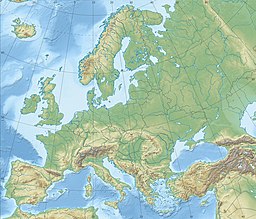| Lake Sevan | |
|---|---|
 Aerial view of the lake | |
| Location | Gegharkunik Province, Armenia |
| Coordinates | 40°19′N 45°21′E / 40.317°N 45.350°E |
| Primary inflows | 28 rivers and streams |
| Primary outflows | evaporation: 85–90%,[1] Hrazdan River: 10–15% |
| Basin countries | Armenia |
| Managing agency | Ministry of Environment |
| Max. length | 74 km (46 mi)[2] |
| Max. width | 32 km (20 mi)[2] |
| Surface area | 1,242 km2 (480 sq mi)[3] |
| Average depth | 26.8 m (88 ft)[3] |
| Max. depth | 79.4 m (260 ft)[3] |
| Water volume | 33.2 km3 (26,900,000 acre⋅ft)[3] |
| Salinity | 0.7%[4] |
| Surface elevation | 1,900.44 m (6,235.0 ft) (2012)[5] |
| Islands | formerly 1 (now a peninsula) |
| Sections/sub-basins | 2 (Major Sevan, Minor Sevan) |
| Settlements | Gavar, Sevan, Martuni, Vardenis |
| Designations | |
|---|---|
IUCN Category II (National Park) | |
| Official name | Sevan National Park |
| Designated | 14 March 1978 |
| Official name | Lake Sevan |
| Designated | 6 July 1993 |
| Reference no. | 620[6] |


Lake Sevan (Armenian: Սևանա լիճ, romanized: Sevana lich) is the largest body of water in both Armenia and the Caucasus region. It is one of the largest freshwater high-altitude (alpine) lakes in Eurasia.[7] The lake is situated in Gegharkunik Province, at an altitude of 1,900 m (6,234 ft) above sea level. The total surface area of its basin is about 5,000 km2 (1,900 sq mi), which makes up 1⁄6 of Armenia's territory.[7] The lake itself is 1,242 km2 (480 sq mi), and the volume is 32.8 km3 (7.9 cu mi).[3] It is fed by 28 rivers and streams. Only 10% of the incoming water is drained by the Hrazdan River, while the remaining 90% evaporates.
Sevan has significant economic, cultural, and recreational value. Its sole major island (now a peninsula) is home to a medieval monastery. The lake provides some 90% of the fish and 80% of the crayfish catch of Armenia.[8]
Sevan was heavily exploited for irrigation of the Ararat plain and hydroelectric power generation during the Soviet period. Consequently, its water level decreased by around 20 m (66 ft) and its volume reduced by more than 40%. Later, two tunnels were built to divert water from highland rivers, which halted its decline and its level began rising. Before human intervention dramatically changed the lake's ecosystem, the lake was at an altitude of 1,916 m (6,286 ft) above sea level,[3] 95 m (312 ft) deep, covered an area of 1,416 km2 (547 sq mi) (5% of Armenia's entire area), and had a volume of 58.5 km3 (14.0 cu mi).
- ^ EEA 2015, p. 9.
- ^ a b EEA 2015, p. 7.
- ^ a b c d e f Vardanian 2009, p. 78.
- ^ O'Sullivan, Patrick; Reynolds, C. S., eds. (2008). The Lakes Handbook: Limnology and Limnetic Ecology. John Wiley & Sons. p. 57. ISBN 978-0-470-99926-4.
- ^ "Water level of Armenia's Lake Sevan rises faster than specified law – official". news.am. 2 March 2013. Archived from the original on 4 March 2016. Retrieved 7 March 2012.
- ^ "Lake Sevan". Ramsar Sites Information Service. Retrieved 25 April 2018.
- ^ a b Babayan et al. 2006, p. 347.
- ^ Babayan et al. 2006, p. 348.



